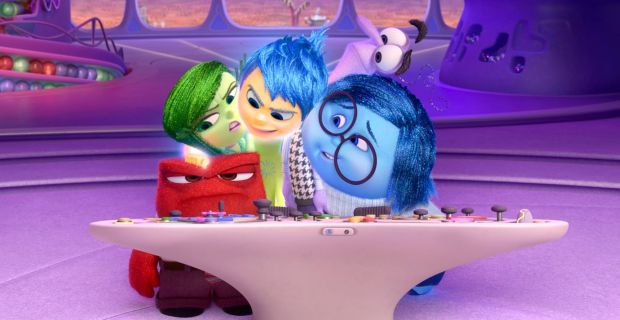
Film: Inside Out
Directed by: Pete Docter, Ronaldo Del Carmen
Starring: Amy Poehler, Bill Hader, Phyllis Smith
Pixar has a knack for crafting stories based in other worlds or worlds that we can’t see with characters that strike the most emotional of chords with their relatable stories. Now, the studio put emotions at the forefront, as their own individual characters. The huge risk pays off, though. Instead of functioning as a surface-level understanding of Fear, Disgust, Anger, Joy and Sadness, Inside Out digs deep to find what makes these emotions tick and how or why they affect things around them. Up there with the best of Pixar’s efforts, Inside Out is funny, heartfelt, gorgeous and heartwrenching.
After eleven-year-old Riley (voiced by Kaitlyn Dias) is forced to move from Minnesota to San Francisco by her parents (Kyle MacLachlan, Diane Lane), the emotions inside of her head have trouble making the best decisions for Riley in this new environment. Joy (Amy Poehler), Sadness (Phyllis Smith), Disgust (Mindy Kaling), Fear (Bill Hader) and Anger (Lewis Black) are Riley’s emotions controlling things via keyboard in headquarters (heh, get it?). After her core memories–memories that define who she is–are lost after a kerfuffle, Joy and Sadness must team up to find them before Riley’s mental stability crumbles.
If there were any fault in Inside Out, it would be in how calculated and cold the plot can be. Sitting at a lean 94-minute runtime, the film succeeds in a fast but insightful introduction before whisking the viewer away to the deep parts of Riley’s psyche. Whether that be Hockeyland (she likes hockey) or Dream Productions (movie studio dedicated to crafting dreams), the narrative has a set course of where it needs to go and gets there with predictability abound. Luckily though, Pixar develops their characters in such a manner that you don’t care about where they go, you just want to be along for the ride with them.
One of the best parts of Inside Out is deterring from that predictability, too. In the beginning, we see everything from Joy’s point of view. What Joy says goes in the mind of Riley, with the other emotions taking control when Joy lets them. Joy is literally removed from the control room in the pursuit of the core memories lost at headquarters. This leaves the other emotions to grapple with controlling how Riley acts and reacts. Their decisions aren’t overshadowed; some play for comedic relief and some are there to argue the point that Joy isn’t the only emotion someone should have. In life, Joy is one of the most important emotions for us to feel and live off of. Sadness, disgust, fear and anger are too, though. If we don’t embrace those times in our lives when we are the saddest, then how can we expect to be happy? This is the argument that Inside Out lands like a gut punch to the heart, in normal Pixar fashion.
The toys almost getting destroyed in Toy Story 3, Carl losing his wife in Up, and almost losing Boo in Monsters Inc. – wait until you meet Sadness and Joy. Inside Out is littered with characters and moments that hit home. Bing Bong (Richard Kind) is the imaginary friend Riley had when she was little who now resides in long-term memory, a snaking expanse of shelves filled with memories held in porcelain-looking globes. Bing Bong represents a bygone time in anyone’s mind, when imagination was at its most loose and when joy could be found in the most simple of tasks. Man, childhood was great. Not to mention that when Kind’s gentle, coddling, and comforting voice is lent to Bing Bong, feelings and memories may get dug up from the deepest parts of the viewer’s brain. This is just a sliver of what Inside Out has to offer, never manipulating the audience to think one way or the other.
The voice cast only makes the narrative more enjoyable. Amy Poehler’s effervescent personality from things like Baby Mama and Parks and Recreation carries over to Joy, an emotion unaware of the people around her, blinded by her drive to make Riley happy. Phyllis Smith (The Office) is fantastic as Sadness, perfectly showing how her respective emotion can be carried around like a burden, feeling alone in a world that doesn’t want to embrace her. A lot of the comic relief comes from Anger, voiced by Lewis Black. Black’s rambunctious comedic tendencies translate perfectly into the role. You barely recognize Bill Hader’s voice as Fear, which furthers the theory that Hader is so multi-faceted, in live action or animation. Mindy Kaling is great as Digust, as well, but she gets the least time to shine amongst everyone else.
Directors Pete Doctor and Ronaldo Del Carmen craft some stunning visuals, perfectly showcasing the human mind as a series of gears trading off to natural and changing visual landscapes. 3D isn’t necessary with Inside Out, but Pixar always does a great job with making sure the finished cuts of their films don’t look like dim eyesores.
Inside Out is Pixar back on the top of their game, like they never skipped a step. Imagination behind animated films is still alive and kicking, constructing stories that resonate with children and adults alike.
GRADE: A-
Written by Sam Cohen (Follow him on Twitter!)
- MOVIE REVIEW: ‘Popstar’ has at least a few hits - June 3, 2016
- MOVIE REVIEW: ‘Neighbors 2: Sorority Rising’ is the rare sequel that tries - May 21, 2016
- MOVIE REVIEW: ‘The Nice Guys’ is a loopy, drunk masterpiece - May 20, 2016
